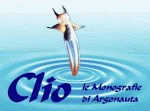
Clio Supplemento a Argonauta 7-12 2012
 |
 |
Nota introduttivaIl nostro Paese è ricco di circa 8.000 chilometri di litorali e spiagge. Fino alla meta del secolo scorso, le spiagge erano dominio dei pochi residenti locali e di qualche famiglia agiata che poteva permettersi vacanze estive al mare.Nell'immediato dopoguerra e, soprattutto,  con il "boom economico" degli anni sessanta e l'avvento delle auto utilitarie, molti italiani conobbero le bellissime spiagge del nostro incantevole Paese. Nacquero così molti stabilimenti balneari e un vasto giro di "indotto locale": dall'affitto di case per l'estate, all'acquisto di generi alimentari di prima necessità, dalla richiesta di alberghi e pensioni adeguatamente economiche alla necessità di rifornirsi di abbigliamento e attrezzature da bagno. con il "boom economico" degli anni sessanta e l'avvento delle auto utilitarie, molti italiani conobbero le bellissime spiagge del nostro incantevole Paese. Nacquero così molti stabilimenti balneari e un vasto giro di "indotto locale": dall'affitto di case per l'estate, all'acquisto di generi alimentari di prima necessità, dalla richiesta di alberghi e pensioni adeguatamente economiche alla necessità di rifornirsi di abbigliamento e attrezzature da bagno.La rapida evoluzione di questo importante settore dell'economia Italiana, che tra l'altro ha attirato grandi quantità di turisti dall'Europa, si è presto scontrata con un problema noto, ma non previsto o sottovalutato: "l'erosione delle spiagge" da parte delle forze naturali del mare. Ingenti patrimoni, in strutture e investimenti collegati a questa attività, sono così stati bruciati, almeno stagionalmente, dagli "agenti atmosferici" e dalla violenza del mare. Così già negli anni '80 si iniziarono azioni di ripristino delle sabbie asportate dal mare con semplici spostamenti di sabbia tra spiagge vicine. Si iniziarono anche a costruire "barriere" che frenassero la potenza delle onde. I primi passi furono condotti con la scarsa preparazione scientifica del tempo e, man mano che si commettevano errori o si ottenevano successi, le tecniche per la soluzione del problema andarono ad affinarsi notevolmente. Solo nell'ultimo decennio è apparsa sui nostri quotidiani la parola "ripascimento" Solo negli ultimi anni si sono organizzati a livello nazionale ed europeo degli organismi per fronteggiare in maniera organica e scientifica questa emergenza. |
Introductory NoteOur country is full of about 8,000 kilometers of coastline and beaches. Until the middle of last century, the beaches were the domain of the few local residents and a few wealthy families could afford that summer vacation to the sea.Immediately after the war, and especially with the "economic boom" of the sixties and the advent of cars small cars, many Italians knew the beautiful beaches of our beautiful country. Thus were born of the beach and an extensive tour of "locally led" by renting houses for the summer, the purchase of food staples, the demand for cheap hotels and pensions adequately to the need to stock up on clothing and bathroom equipment. The rapid evolution of this important sector of the Italian economy, which also attracted large numbers of tourists from Europe, he soon clashed with a known issue but not planned or underrated "beach erosion" by natural forces of the sea. High net worth, investment in structures and attached to this activity, have thus been burned, at least seasonally, by "weathering" and the violence of the sea. So back in the 80 years began proceedings to restore the removed sand from the sea with  a simple movement of sand from nearby beaches. He also began to construct "barriers" that would decrease the power of the waves. a simple movement of sand from nearby beaches. He also began to construct "barriers" that would decrease the power of the waves.The first steps were carried out with little preparation time and, as they made mistakes or successes were achieved, the techniques for the solution of the problem came to be refined considerably. Only in the last decade has appeared in our newspapers the word "nourishment" Only in recent years have been organized at national and european bodies to address in a systematic and scientific this emergency. |
